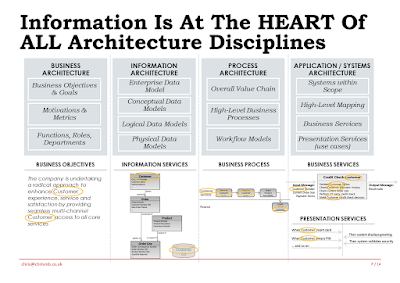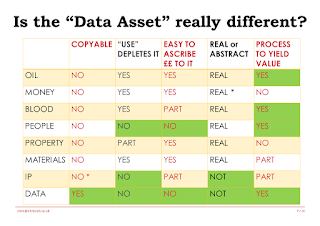In June 2015 for the BCS and DAMA I presented a seminar at an event called "Data, the vital organisation enabler" Information is at the Heart of ALL of the Business
During this I raised the question, "is the data asset really that much different form other assets?" We hear a great deal that Data is an asset, it's got to be managed, few people in the business understands us and so on.
Don't get me wrong, I'm not trying to cast doubt on the importance of data as an asset, but I wanted to raise the level of debate from a subliminal nod to a conscious examination of the characteristics of different "assets" and to compare them with the 'Data asset".

Firstly, let me re-iterate that Information IS absolutely at the heart of the business, my recent white paper talks at some length about this and the diagram here briefly illustrates 4 business architecture disciplines & the vital role of data in each of these.
However what I want to raise here is just what are some of the characteristics of core assets in the business, and if as we all say data IS one of those key assets, how, if at all do these characteristics differ in the "Data asset" compared with other common assets that we frequently encounter in our organisations?
The assets I've selected for this comparison are:
* Oil
* Money
* Blood
* People
* Property
* Materials
* Intellectual Property (IP) and of course
* Data.
The characteristics of the assets themselves required more consideration. After much thought and batting the notion around with others I settled upon these 5 characteristics:
Data is copyable; with digital media any number of copies can be taken without the data being degraded. Using data does not erode it or make it wear out. Sure the relevance of the data may decrease over time but it does not wear out. Whilst there is much talk about "monetizing" data, this is still not a widespread practice but will no doubt become some in the future. Data is an abstract concept since its representing something else. Data needs to be utilised by processes to have value (and conversely processes must have data to operate upon).
If we look for assets which have the same values of characteristics as observed in "data" then we're going to be disappointed. Of the 5 characteristics, 3 of the assets (Money, Property and Materials) have zero common values of characteristics.
2 of assets (Oil and Blood)have one common characteristic value shared with "Data". Intellectual Property (IP) has two common characteristics, and heading the pack with three common characteristics is People. It's interesting to note though, that there aren't any of the assets that share 4 let alone 5 of the characteristics as we see in Data.

Thus it's probably reasonable to conclude that: the Data Asset IS different to other business assets that we encounter.
Furthermore, as described in my white paper all of the business depends upon data for its wellbeing.
Unfortunately, we still encounter organisations where the various disciplines of Information Management are not understood (or more frighteningly are knowingly not addressed). Indeed, Professor Joe Peppard wrote "The very existence of an organisation can be threatened by poor data quality.” So yes if as we suggest here that it is different, then the management of the data asset requires specific skills and capabilities, the Information professional.
Wise organisations are realising that Information IS a vital asset, it IS worthy of being managed professionally, and yes it IS different.
During this I raised the question, "is the data asset really that much different form other assets?" We hear a great deal that Data is an asset, it's got to be managed, few people in the business understands us and so on.
Don't get me wrong, I'm not trying to cast doubt on the importance of data as an asset, but I wanted to raise the level of debate from a subliminal nod to a conscious examination of the characteristics of different "assets" and to compare them with the 'Data asset".

Firstly, let me re-iterate that Information IS absolutely at the heart of the business, my recent white paper talks at some length about this and the diagram here briefly illustrates 4 business architecture disciplines & the vital role of data in each of these.
However what I want to raise here is just what are some of the characteristics of core assets in the business, and if as we all say data IS one of those key assets, how, if at all do these characteristics differ in the "Data asset" compared with other common assets that we frequently encounter in our organisations?
Assets & Characteristics
So first of all lets have a think about some other "assets"? I've picked 7 other assets seen across a variety of businesses and tried to compare them with the "data asset".The assets I've selected for this comparison are:
* Oil
* Money
* Blood
* People
* Property
* Materials
* Intellectual Property (IP) and of course
* Data.
The characteristics of the assets themselves required more consideration. After much thought and batting the notion around with others I settled upon these 5 characteristics:
- Is the asset Copyable, i.e. without resorting to the realms of science fiction "replicator" machines
- Does use of the asset in some way deplete it
- Is it straightforward, and/or usual practice to ascribe a monetary value to the asset
- Is the asset a real tangible thing or an abstract concept
- Does the asset have to be processed in some way to yield value
Analysis
So let's analyse these assets against the characteristics & see what (if any) conclusions we can draw from it?Oil
Oil is not copyable, and most definitely using it depletes it. It is definitely usual practice to give a value to oil (the $50 barrel for example) and it is a real concept. Finally it has to be processed to be turned into something useful like petrol, diesel or plastic.
Money
So you can't (legitimately) copy money, and as I know all too well with two sons at University, using money depletes it, and naturally you give a value to money. It's mostly a real concept being underpinned by Gold stock, and doesn't have to be "processed' to deliver value.Blood
Blood isn't copyable in the mainstream (although as we speak blood substitutes are being trialled), and use of it depletes it (it has to be re-cleaned & oxygenated after use). It's not too difficult to ascribe a value to it, and it is a real concept. Finally it has to be processed by our organs to yield value.People
People as we know them are not copyable (although biological cloning is possible). I've said that use of people does not deplete the resource as we can apply our skills & intellect many many times. However, people do age and limbs and minds fade so perhaps this should be answered as "partly true". It's not widespread practice to ascribe a monetary value to a person except in a few cases (e.g. professional sportsmen). People are real and without trying to get too philosophical, they have to do something to yield a value.Property
Property such as buildings are not copyable. Sure you can have a plan for a building & use that several times, but its using different bricks, is on a different site and so on. The Eiffel Tower in China is a fake! Using a property does slowly erode it, things wear out and need to be maintained. Property does have value & it's usual practice to give it such. Property is a real concept, but doesn't have to be processed to generate value.Materials
So here I'm talking about raw materials. Again, without a sci-fi replicator they are not copyable, and just like a match the act of using them depletes them. Most materials have a monetary value easily ascribed to them, for several that's the basis of the commodities market. They are real not abstract things and pretty much for the most part have to be processed to yield a value.Intellectual Property (IP)
IP is not legally copyable. IP thrives on being reused so is not depleted by use. There is frequently a monetary value allocated to IP and much like a thought or an idea it's mostly an abstract concept. Finally, IP must be used (processed) to gain real value from it.Data
So what about data; how does this stack up against the asset characteristics?Data is copyable; with digital media any number of copies can be taken without the data being degraded. Using data does not erode it or make it wear out. Sure the relevance of the data may decrease over time but it does not wear out. Whilst there is much talk about "monetizing" data, this is still not a widespread practice but will no doubt become some in the future. Data is an abstract concept since its representing something else. Data needs to be utilised by processes to have value (and conversely processes must have data to operate upon).
Conclusion
Having looked at these 8 different assets, and the 5 characteristics is there anything that jumps out at us?If we look for assets which have the same values of characteristics as observed in "data" then we're going to be disappointed. Of the 5 characteristics, 3 of the assets (Money, Property and Materials) have zero common values of characteristics.
2 of assets (Oil and Blood)have one common characteristic value shared with "Data". Intellectual Property (IP) has two common characteristics, and heading the pack with three common characteristics is People. It's interesting to note though, that there aren't any of the assets that share 4 let alone 5 of the characteristics as we see in Data.

Thus it's probably reasonable to conclude that: the Data Asset IS different to other business assets that we encounter.
Furthermore, as described in my white paper all of the business depends upon data for its wellbeing.
Unfortunately, we still encounter organisations where the various disciplines of Information Management are not understood (or more frighteningly are knowingly not addressed). Indeed, Professor Joe Peppard wrote "The very existence of an organisation can be threatened by poor data quality.” So yes if as we suggest here that it is different, then the management of the data asset requires specific skills and capabilities, the Information professional.
Wise organisations are realising that Information IS a vital asset, it IS worthy of being managed professionally, and yes it IS different.




